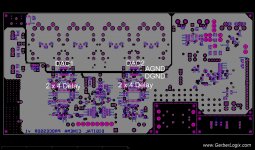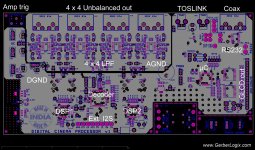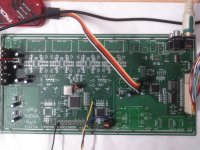What extra features would the hacked AVR + the DIY cinema processor combo offer compared to the original non-hacked AVR?
The processing chip I'm planning to use (STA309A/STA311B) has 10 biquads per "processor channel". Setting aside 2/10 for crossover duties, 8/10 would still be left for paraEQ purposes. Now, let us consider an example where processor channels 1&2 are setup for 2-way reproduction of the 'L (left)' decoder channel using a 4th order Linkwitz Riley slope at 1kHz:
Ch1: L(low band)
Biquads 1 & 2 : 2nd order Butterworth lowpass, 1kHz corner. ( LinkRiley = Butter^2 )
Biquads 3 - 10: ParaEQ x 8
Ch2: L(high band)
Biquads 1 & 2 : 2nd order Butterworth highpass, 1kHz corner.
Biquads 3 - 10: ParaEQ x 8
It is fairly easy to see from the above, that the effective processing power available (apart from crossover) for the L (left) channel is equal to 8+8=16 paraEQ. Now, even if one chooses to perform a 6th/8th order crossover, he would still be left with enough paraEQ to carry out the best room / speaker compensation schemes available. The delay lines in each channel would also allow for precise time-alignment required for excellent multi-way reproduction.
Isn't that all the processing one would ever need to run a home cinema system?
I went ahead with the hardware decoder chip in hand while also including I2S input ports for external decoding solutions. The PCM1680/1 DAC was easy while the new ESS chip looked less friendly and hard to locate.
Attached below are the component placements for the top/bottom layers and ground plane layer (routing layers not shown).
Attached below are the component placements for the top/bottom layers and ground plane layer (routing layers not shown).
Attachments
Also, my schematics are similar to the datasheet reference circuits given by the respective manufacturers. Will be reviewing the files for any mistakes / improvements / modifications for few more days before sending it out for printing.
Please point out any potential issues you might find with the layout etc., thanks.
Please point out any potential issues you might find with the layout etc., thanks.
Last edited:
Got the PCB fabricated and partially populated (picture) for checking decoder stage operation. Since the DACs have not been populated, the analogue audio for the testing (for now) comes from filtering the DDX outputs of the processor chip.
So far, everything seems to be working as expected, with the decoder being able to detect, decode and also report the details of audio formats, as shown in the video (attached, rename to MP4 after downloading).
So far, everything seems to be working as expected, with the decoder being able to detect, decode and also report the details of audio formats, as shown in the video (attached, rename to MP4 after downloading).
Attachments
An idea for a diy ATMOS decoding is to get this evaluation board -
https://www.analog.com/en/education/education-library/videos/5289338616001.html
It gives 24 channels of analog output.
I don't know whether all of the work is done for you or if there is much work to get it running.
I would love to see a freeDSP / kickstarter project based on using that DSP (it costs about $40 ea)
https://www.analog.com/en/education/education-library/videos/5289338616001.html
It gives 24 channels of analog output.
I don't know whether all of the work is done for you or if there is much work to get it running.
I would love to see a freeDSP / kickstarter project based on using that DSP (it costs about $40 ea)
.... DSP (it costs about $40 ea)
And the licence ? What does that cost?
That's what I don't know.And the licence ? What does that cost?
Just wanted to put it out there in case someone with enough free time wants to look into the details.
Managed to design a simple, clutter-free GUI template for JHD12864E, the description for which is attached below (pdf). Also attached is a browser-based (mock) interface for anyone interested in experiencing the layout / navigation of the same. The actual GUI, operated similarly, using a remote control, is currently under testing.
Usage:
1) Extract the zip file to a folder and open "Index.htm". Use Mozilla Firefox for best results (developed on 52.9.0, 32-bit).
2) Explanations are in the accompanying pdf file.
Usage:
1) Extract the zip file to a folder and open "Index.htm". Use Mozilla Firefox for best results (developed on 52.9.0, 32-bit).
2) Explanations are in the accompanying pdf file.
Attachments
The unit is ready after almost a year !!
- The SMPS used in the testing stage has been ditched in favour of a transformer power supply for better EMI performance (waveforms attached).
- In order to assess the decoding fidelity as well, the 48kHz/16-bit DTS-1536kbps format was used during sine-wave testing.
- A video demonstrating the filter save/recall features of the unit is also attached (rename file to *.MP4 after downloading).
Attachments
-
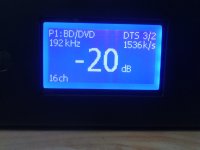 LCD close.JPG141 KB · Views: 166
LCD close.JPG141 KB · Views: 166 -
 Linear PS zoom.JPG259.2 KB · Views: 143
Linear PS zoom.JPG259.2 KB · Views: 143 -
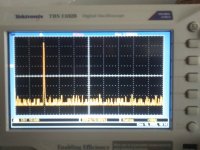 Linear PS FFT.JPG249.9 KB · Views: 135
Linear PS FFT.JPG249.9 KB · Views: 135 -
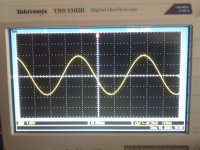 Linear PS.JPG262.3 KB · Views: 133
Linear PS.JPG262.3 KB · Views: 133 -
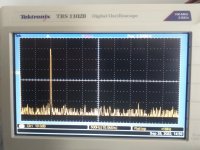 SMPS FFT.JPG269.6 KB · Views: 128
SMPS FFT.JPG269.6 KB · Views: 128 -
 SMPS.JPG269 KB · Views: 181
SMPS.JPG269 KB · Views: 181 -
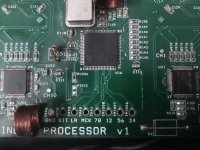 DSP closeup.JPG306.3 KB · Views: 197
DSP closeup.JPG306.3 KB · Views: 197 -
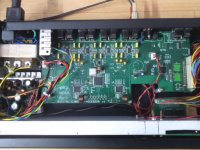 Inside.JPG313.8 KB · Views: 204
Inside.JPG313.8 KB · Views: 204 -
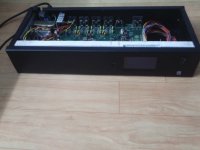 Overall.JPG194.8 KB · Views: 190
Overall.JPG194.8 KB · Views: 190 -
Rename to MP4.txt8.1 MB · Views: 573
Last edited:
Hello everyone !
I have since many years an idea of a product that will bridge the Pro and Consumer world...it's not an easy task.
Anyway, if you have 5K$ you can buy this to decode Dolby Atmos and DTS:X and output it to AES3 or Audio over I/P protocol :
https://www.arvus.com/atmos-h2-4d.html
Cheers.
I have since many years an idea of a product that will bridge the Pro and Consumer world...it's not an easy task.
Anyway, if you have 5K$ you can buy this to decode Dolby Atmos and DTS:X and output it to AES3 or Audio over I/P protocol :
https://www.arvus.com/atmos-h2-4d.html
Cheers.
Also added the Bessel type to crossover filters, based on an article on a "Perfect reconstruction crossover" by @gberchin, from another thread.
Would you care to elaborate a little on your idea, please?I have since many years an idea of a product that will bridge the Pro and Consumer world...it's not an easy task.
- Home
- Source & Line
- Digital Line Level
- DIY cinema processor - requirements, preferences, opinions, ideas ?
